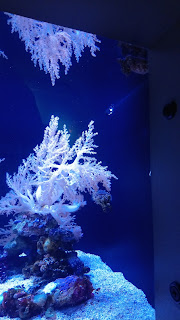A field trip to the Seattle Aquarium
I went on a field trip to the Seattle Aquarium on the February 28th.
The main two reasons why I choose this field trip are that I do not have the gear for snowshoeing and I have been to the zoo before.
That day was a rainy day, but it was not rainy inside both the aquarium and the car =]
The first exhibition area is the Life on the Edge.
In this area, various species from Porifera, Cnidaria to Chordata are displayed.
The best point for me is that we can touch different organisms.
In the pictures above, they are mostly sea stars.
Beside sea stars, there are also different species like Green anemone, Sea urchin, and California sea cucumber.
There are also some naturalists who would introduce the organisms to us.
There are two parts of their explanation that interest me most.
The first part is watching them feed the organisms.
When someone put a piece of fish beside a green anemone, it would sense and grab the food inside. That shows us why we will feel sticky when touching them.
The second part is the special tour that shows us how they reproduce.
Plenty of organisms reproduce in the winter.
We can not only find out how some species attract opposite sex, but also the appearance of their eggs and how they protect them.
In the photos below, there are two kinds of eggs the naturalist showed us.
The second exhibition area is the Birds and Shores.
In this area, there are several shorebirds and seabird species.
Luckily, there is a black oystercatcher that is kind enough for me to take pictures in a short distance.
This is a species that found along Washington’s intertidal coast.
The main threats to shorebirds are litter, pollution and habitat loss due to development.
To help them in real life, simply by disposing litter properly and keeping yourself away from them can minimize our effect on them.
The third exhibition area is the Salmon in our Watershed.
In this area, the life cycle of a salmon from going downstream, in the estuary, ocean life, and return to streams and rivers is exhibited.
A fun fact about them is that salmon are silver while they live in the sea and change to bright colors when they enter fresh water.
Plenty salmon population in the Pacific Northwest are listed as endangered.
The four main factors for them to live are habitat, harvesting, hatcheries, and hydropower.
By keeping a clean ocean, controlling the fishing, operating their hatcheries and managing location of the dams can help this species with this special life cycle.
The fourth exhibition area is the Marine Mammal Exhibit.
In this area, there is a diver show before we leave.
The diver told us that the fish inside may look at their neighbors differently after ½ days if they are not fed =]
Also, the reason why they cannot just feed them from the top is that there are different predators and they might not get a fair share of food.
The last exhibition area is the Tropical Pacific.
In this area, the most interesting species to me is the dwarf cuttlefish.
This kind of cuttlefish has specialized cells in their skin that allow them to change not only colors, but also texture rapidly.
In my opinion, going to the aquarium is an excellent choice for a biology field trip. Normally, the limit of going to the aquarium is that we cannot have direct touch with the organism.
Watching through glasses through the whole trip will be a bit boring.
However, there is an exhibition area that allows us to touch them.
Although we can only touch invertebrate, this is already a really rare and fun experience for us.
Moreover, the aquarium shows the largest variable of organisms in different phyla so we can be directly exposed to some of them.
It always feels good when what we learn in the textbook links to what we see in real life.











Hey Joseph! Your post is so funny! I didn't get to see the feeding of the anemone! I wish I saw that because that sounded really fun! We learned that Cnidaria only have a nerve net, but it's interesting that it is sensitive enough for the anemone to sense the fish. Also I love the picture you took of the bird we saw. He was so cute. Also, I agree that the dwarf cuttlefish is super interesting. They are really similar to that giant octopus and how they can change color according to their environments. I wonder how they can sense the environment and change color. Super cool. Anyways, great post!
ReplyDeleteHi! It would be fun to go to the aquarium. It is very fun to look at different aquatic animals. It is also very interesting to learn about the salmons. I also found the cuttlefish that you mentioned was very interesting. It can change colors and texture rapidly.
ReplyDelete